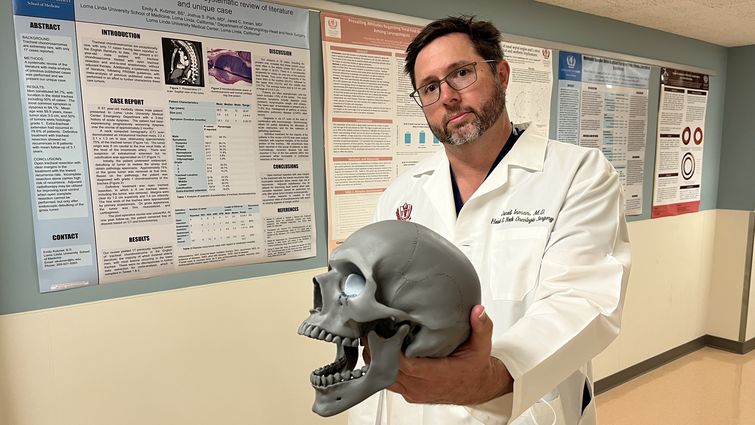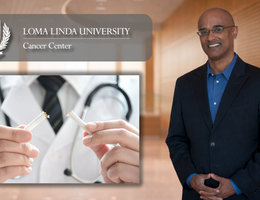

Dr. Jared Inman holds a 3D replica of a human skull around which various cancers can form.
While head and neck cancers represent a broad category for numerous cancers, a set of five controllable risk factors contribute to most head and neck cancers, says Jared Inman, MD, a head and neck surgical oncologist at Loma Linda University Health. For April’s Head and Neck Cancer Awareness Month, Inman outlines how reducing these five risks in your life can help prevent head and neck cancers.
Head and neck cancers, those cancers occurring above the shoulder bones not including brain cancers, occur in the voice box, throat, tongue, mouth, sinus, nose, ear, eyes, as well as other places.
Squamous cell cancers are by far the most common types of head and neck cancers, says Inman, and can happen in any location of the head and neck. Therefore, the risk factors and Inman's prevention tips pertain especially to squamous cell cancers.
Tobacco and alcohol
Tobacco, which includes secondhand smoke and smokeless tobacco, is the number one stand-alone risk factor for head and neck cancers, Inman says, with alcohol consumption a close runner-up. Additionally, he says combined tobacco and alcohol use places people at a greater risk of developing these cancers than those who use tobacco or alcohol alone. Most head and neck squamous cell carcinomas of the mouth and voice box are caused by tobacco and alcohol use, according to the National Cancer Institute.
“Head and neck cancers are almost always tied to smoking and drinking alcohol,” says Inman.
Quitting smoking and avoiding alcohol is the best way to prevent head and neck cancers, Inman says. Even certain alcohol-based mouthwashes have been associated with higher rates of oral cancers, Inman says; he advises opting for natural-based, organic mouthwash.
Viral infections
Two viral infections — the human papillomavirus (HPV) and Epstein-Barr virus (EBV) — raise the risk of head and neck cancers. EBV can increase the risk of cancers in or behind the nose and in the salivary glands, according to the Centers for Disease Control and Prevention (CDC). Meanwhile, the CDC links HPV to an estimated 70% of cancers in the oropharynx, which includes the tonsils, soft palate, and base of the tongue. Moreover, studies state that head and neck cancers caused by HPV have increased by 255% in the past decades.
Read more: Researchers detect molecule to counter protein in cancer-causing human papillomavirus
HPV and EBV are extremely common, Inman says. Studies dating from the 2000s found most newborns carried at least one of the 300 sub-types of HPV — 20 of which have a higher rate of causing cancers.
“It’s important to demystify these viruses because we believe that almost everyone has them,” he says. “Most people are born with the virus, and their immune systems control it.”
However, it is repetitive, chronic infections of these viruses and their different strains over time that Inman says could cause degeneration into head and neck cancers. Many patients experience viral-mediated head and neck cancers between their 50s and 60s, he says. These viral-caused cancers occur about a decade sooner than patients whose head and neck cancers developed from alcohol and tobacco. He says while both groups of patients receive the same treatments, those with virus-mediated cancers experience a 30% survival or cure advantage.
Inman says some of the best ways to prevent repetitive exposure to the viruses include avoiding item-sharing that involves bodily fluids like saliva, using barrier methods during sex, and getting the HPV vaccine.
Read more: Updates in HPV and pneumonia vaccines
Finally, Inman says taking steps to actively support and boost the immune system through a healthy lifestyle helps the body fight infections and cellular changes.
Ultraviolet exposure
Prolonged exposure to ultraviolet (UV) radiation — either through artificial means like indoor tanning beds or naturally from the sun — plays a significant role in developing cancer in the lip area and skin cancer of the head and neck, Inman says.
He says wearing a UV-protective hat and applying sunscreen to the face and neck, including the lips, with sunscreen-containing lip balms are the best prevention measures.
Read more: Lesser-known risks for skin cancer and prevention tips
Oral health
Poor oral health and dental hygiene can lead to developing oral cancer over time, Inman says, along with repetitive trauma to tissues of the tongue and cheeks.
“If you have a sharp crown or a fractured tooth, and your tongue or cheeks scrape against that dental damage, you can get long-lasting sores in your mouth that can degenerate into oral cancer,” he says.
Inman recommends regularly visiting the dentist, who will guide dental hygiene, help treat oral ailments, and identify potential head and neck cancers early when they are easier to treat.
Talk with your healthcare provider if you have questions about head and neck cancers. Learn more about the Cancer Center’s head and neck cancers screening and treatment options online or call 1-800-782-2623 to make an appointment.

